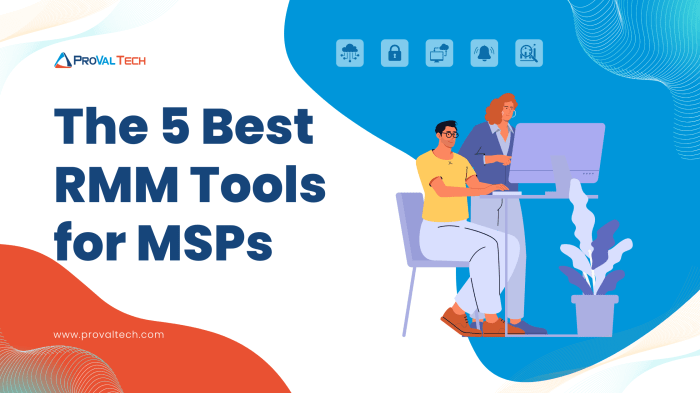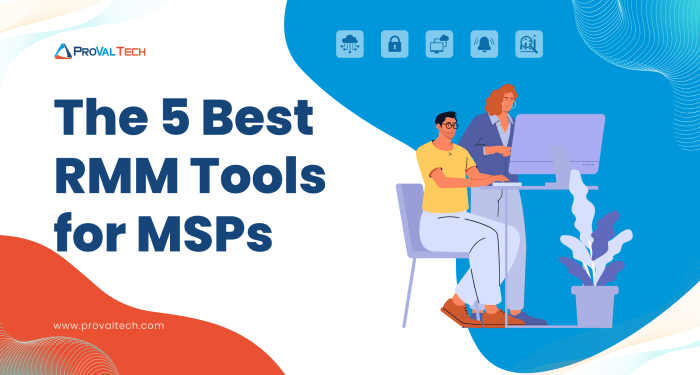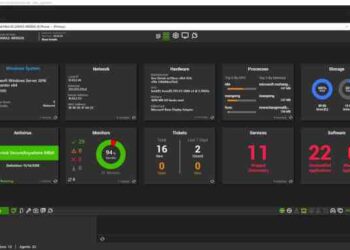Exploring the top RMM software options tailored for small to medium-sized MSPs, this introduction sets the stage with a captivating narrative that draws readers in from the start.
Providing valuable insights into the importance of RMM software for managing IT infrastructure and the key features essential for MSPs, this paragraph offers a comprehensive overview of the topic.
Overview of RMM software for small to medium-sized MSPs

Remote Monitoring and Management (RMM) software plays a crucial role for small to medium-sized Managed Service Providers (MSPs) in efficiently managing their clients' IT infrastructure remotely.
Key Features to Look for in RMM Software
- Automated Monitoring and Alerts: RMM software should provide real-time monitoring of networks, servers, and endpoints, along with customizable alerts to quickly address any issues.
- Remote Access and Control: The ability to remotely access and troubleshoot client systems is essential for MSPs to resolve problems without the need for on-site visits.
- Patch Management: RMM software should offer automated patch management to ensure that client systems are up to date and secure against vulnerabilities.
- Inventory Management: Keeping track of hardware and software inventory helps MSPs with asset management and planning for upgrades or replacements.
- Reporting and Analytics: Comprehensive reporting capabilities allow MSPs to demonstrate the value of their services to clients and make data-driven decisions for improvements.
Challenges Faced by Small to Medium-sized MSPs Addressed by RMM Software
- Resource Constraints: RMM software helps optimize resources by automating routine tasks, reducing manual intervention, and improving operational efficiency.
- Scalability: As MSPs grow their client base, RMM software enables them to scale their operations without compromising service quality or increasing overhead costs significantly.
- Security Concerns: With the rise in cyber threats, RMM software enhances security measures by monitoring for suspicious activities, managing patches, and ensuring compliance with security protocols.
- Client Satisfaction: By proactively monitoring and managing IT infrastructure, MSPs can prevent downtime, minimize disruptions, and deliver better service quality, leading to higher client satisfaction and retention rates.
Factors to consider when choosing the best RMM software
When selecting the best RMM software for small to medium-sized MSPs, there are several crucial factors to take into account to ensure that the chosen solution meets the specific needs and requirements of the business. From pricing models to scalability and integration capabilities, each aspect plays a vital role in determining the effectiveness and efficiency of the RMM software.
Compare pricing models of different RMM software options
When evaluating RMM software options, it is essential to compare the pricing models offered by different providers. Some RMM solutions may have a flat-rate pricing structure, while others may charge based on the number of endpoints or devices being managed.
Understanding the pricing models and how they align with the MSP's budget and growth projections is crucial in making an informed decision.
Discuss the scalability of RMM software for small to medium-sized MSPs
Scalability is another critical factor to consider when choosing RMM software for small to medium-sized MSPs. The software should be able to grow and adapt alongside the business as it expands its client base and services. It is important to assess whether the RMM solution can handle an increasing number of endpoints, users, and functionalities without compromising performance or efficiency.
Analyze the integration capabilities with other tools that are essential for MSP operations
Integration capabilities with other essential tools used in MSP operations, such as PSA (Professional Services Automation) software, remote access tools, and security solutions, are vital for streamlining workflows and maximizing productivity. The chosen RMM software should seamlessly integrate with existing systems to ensure smooth data flow and communication between different platforms, ultimately enhancing the overall efficiency and effectiveness of the MSP operations.
Top RMM software solutions suitable for small to medium-sized MSPs
When it comes to choosing the right Remote Monitoring and Management (RMM) software for small to medium-sized Managed Service Providers (MSPs), there are several popular options in the market that cater specifically to their needs. These solutions offer a range of features and functionalities to help MSPs efficiently manage their clients' IT infrastructure and provide proactive support.
SolarWinds RMM
SolarWinds RMM is a comprehensive RMM solution that offers remote monitoring, management, and automation tools tailored for MSPs. One of its standout features is its intuitive dashboard that provides a centralized view of all managed devices and allows for easy troubleshooting.
SolarWinds RMM also includes patch management, antivirus protection, and backup solutions, making it a well-rounded option for MSPs.
NinjaRMM
NinjaRMM is another popular choice among small to medium-sized MSPs due to its user-friendly interface and robust feature set. This cloud-based RMM platform offers device monitoring, patch management, remote control, and scripting capabilities. NinjaRMM's automation features help streamline IT operations and improve efficiency for MSPs.
ConnectWise Automate
ConnectWise Automate, formerly known as LabTech, is a powerful RMM platform that offers extensive automation capabilities to help MSPs manage and monitor their clients' systems effectively. Its scripting engine allows for custom automation tasks, while its integration with ConnectWise Manage streamlines ticketing and billing processes.
ConnectWise Automate is a scalable solution suitable for growing MSPs.
Kaseya VSA
Kaseya VSA is a comprehensive RMM solution that provides monitoring, management, and automation tools for MSPs of all sizes. Its remote control capabilities, patch management, and network discovery features make it a versatile option for small to medium-sized MSPs. Kaseya VSA also offers a mobile app for on-the-go monitoring and management tasks.Overall, each of these RMM software solutions brings unique strengths and capabilities to the table, catering to the specific needs of small to medium-sized MSPs.
When choosing the best RMM software for your MSP, consider factors such as ease of use, scalability, feature set, and integration capabilities to find the right fit for your business.
Case studies or success stories of small to medium-sized MSPs using RMM software
Implementing RMM software has proven to be a game-changer for many small to medium-sized MSPs, enhancing their operations and overall business performance. Let's explore some real-life examples of MSPs who have benefited from using RMM software.
Case Study 1: XYZ IT Solutions
- Improved response time to client issues
- Increased efficiency in managing client networks
- Enhanced security measures for client data
XYZ IT Solutions, a small MSP with a growing client base, struggled to efficiently manage multiple networks and endpoints. By adopting RMM software, they were able to automate routine tasks, monitor systems in real-time, and proactively address issues before they escalated.
This led to a significant increase in their productivity and customer satisfaction levels.
Key Benefits:
Case Study 2: ABC Managed Services
- Higher client retention rates
- Increased profitability through cost savings
- Scalability to accommodate business growth
ABC Managed Services, a medium-sized MSP, faced challenges with scaling their operations due to manual processes and limited visibility into client environments. After implementing RMM software, they experienced a streamlined workflow, better resource utilization, and reduced downtime for their clients.
This allowed them to take on more clients and expand their service offerings.
Key Outcomes:
Final Wrap-Up
In conclusion, this discussion has shed light on the significance of selecting the right RMM software for small to medium-sized MSPs, emphasizing the need for scalability, integration capabilities, and user-friendly interfaces.
Answers to Common Questions
What are the key features small to medium-sized MSPs should look for in RMM software?
Small to medium-sized MSPs should prioritize features like remote monitoring, automated patch management, network discovery, and customizable reporting in RMM software.
How does RMM software benefit small to medium-sized MSPs?
RMM software helps MSPs efficiently manage and monitor clients' IT infrastructure, automate routine tasks, improve response times, and enhance overall productivity.
What pricing models are available for RMM software?
Common pricing models for RMM software include per-device pricing, per-technician pricing, and tiered pricing based on the number of endpoints managed.





![Top 10 RMM Solutions [2024] | NinjaOne](https://ecommerce.mardinata.com/wp-content/uploads/2025/10/Best-RMM-Software-and-Tools-1-120x86.jpg)




